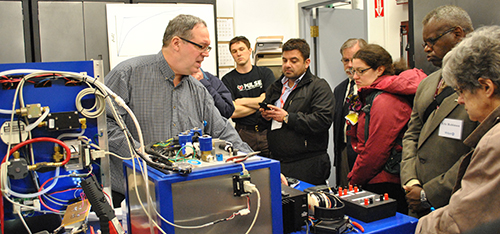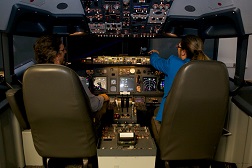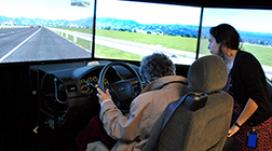Volpe Welcomes the Public During Cambridge Science Festival
If you could peer inside the walls of Volpe on any given day, you’d find a flurry of transportation research happening across every floor throughout every building at our Cambridge campus. From making air travel safer and more efficient, to using software to make smart intercity travel choices, to tracking vessels that navigate the world’s waterways, Volpe’s research imprint is truly global.
But Volpe’s impact begins locally. Recently, Volpe offered the public a snapshot of its multimodal transportation research when it opened its doors to the Cambridge- and Boston-area community as part of the 2015 Cambridge Science Festival. More than two dozen people came to Volpe to learn about staff work that is primed to change the transportation world—and to operate our train, airplane, and vehicle simulators.

Researcher Ed Conde, who runs Volpe’s Alcohol Countermeasures Laboratory, explains that Volpe evaluates all models of alcohol testing devices to ensure that they meet federal specifications.
The Breadth of Volpe’s Investigations
The open-house event began with presentations from Volpe engineers working on notable projects. Kathryn Bernazzani shared her work on aircraft wake turbulence, the swirling air that comes off an airplane’s wings as it flies. The wake of a large leading airplane can create turbulence for a smaller, trailing airplane if there is inadequate space for the wake to fade.
“There are separation standards, which depend on aircraft size and weight, and on whether an aircraft is following or leading,” Bernazzani said. “Our research is on minimum safe spacing, to make sure that when aircraft are taking off or landing, the separations between aircraft are at a safe range.”
The Volpe wake team’s research is informing Federal Aviation Administration (FAA) wake separation standards. Now smaller airplanes can fly in front of larger ones with less separation. Smaller separations allow for more flights to land in less time, reducing delays at congested airports.
Principal technical advisor Ruth Hunter was up next, with more research that’s reducing delays and making our airspace safer. Hunter studies the breadth of safety impacts of FAA’s Next Generation Air Transportation System (NextGen). Improved digital communications—how pilots respond to printed messages in the cockpit instead of spoken instructions—is one key element of NextGen. Printed messages may reduce the back-and-forth of air traffic controllers repeating information for pilots.
“Printed visual messages in the cockpit can improve situational awareness immensely, particularly for foreign pilots who may find it difficult to understand the accents of air traffic controllers,” Hunter said.
From the skies back down to the earth, safety information engineer Brian Sumner presented his work on web and mobile applications that make federal highway safety data more accessible. SaferBus, SaferCar, and QCMobile are all free, valuable tools for bus passengers, car buyers and owners, law enforcement, insurers, and others.
“Say you’re looking for a bus from Boston to New York,” Sumner said. “You’re looking online and find a bus company you’ve never heard of—but they have good prices. How do you know whether you can feel safe traveling on that company? The idea with SaferBus is that you can quickly access federal safety records on that bus line.”
Finally, Kam Chin, chief of Volpe’s Situational Awareness and Logistics Division, talked about his team’s innovations in tracking vessels around the world. With tracking technology called the Automatic Identification System (AIS)—an electronic beacon mandatory on some American ships but voluntary elsewhere in the world—governments share AIS data with other governments to create a global tracking system that supplements radar. AIS data refines ship location information, and it helps governments identify ship crews engaging in illegal activity.
Taking to the Rails, Skies, and Roads
 After the presentations, guests from the local community got a rare chance to sit in Volpe’s simulators. The train, airplane, and car simulators are used for human factors experiments in which researchers study how participants handle various new or dangerous scenarios—such as what drivers do when their brakes stop working. The Boeing 737 simulator was used to test the work that Hunter discussed on pilot-controller communication.
After the presentations, guests from the local community got a rare chance to sit in Volpe’s simulators. The train, airplane, and car simulators are used for human factors experiments in which researchers study how participants handle various new or dangerous scenarios—such as what drivers do when their brakes stop working. The Boeing 737 simulator was used to test the work that Hunter discussed on pilot-controller communication.
Guests also received a tour of Volpe’s Alcohol Countermeasures Laboratory, where researchers evaluate all models of alcohol testing devices to ensure that they meet federal specifications. Researchers also evaluate other alcohol testing technologies, such as ignition interlock devices, disposable or reusable personal breathalyzers, passive breath testers, and devices that test for fluids other than alcohol.
This event is part of Volpe’s move towards increasing its science, technology, engineering, and math (STEM) outreach in the local community.
Keep an eye on the Volpe website and our X feed, @VolpeUSDOT, for more public events—and maybe we’ll see you in one of Volpe’s simulators in 2016.

During the 2015 Cambridge Science Festival, a visitor test drives Volpe's driving research simulator, used for human factors experiments. (Volpe photo).
